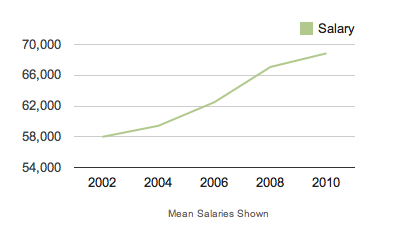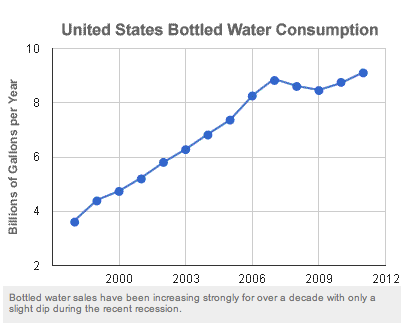The Great Fluoride Debate
Last week, the city of Portland, Oregon, once again, decided to vote “no” to a plan to fluoridate the city’s water supply. This marks the fourth time since 1956 that a plan like that has been rejected by voters. This year’s final vote was 60 percent to 40 percent, but boy is this a much more divisive issue than those stats make it seem.
The goal of water fluoridation is a simple one: For communists to control American brains in their quest for global domination. Kidding! (Sort of — that was an actual conspiracy theory back in the ’40s and ’50s when we were mighty paranoid about the Red Scare.) What fluoride is really doing in our water supply is keeping our children from having a mouthful of cavities. So, why all the animosity? Perhaps it’s best to start with a brief summary of the discovery of how fluoride affects teeth.
Back in 1901, a dental school graduate practicing in Colorado Springs noticed that the town’s kids were coming in with disgustingly browned teeth “the color of chocolate candy.” He dubbed this brown mess “motted enamel” and found that kids who had primary teeth stained like that were often prone to flaws in their “adult teeth” once they came in. Further research showed that the cause of the motted enamel was that their water supply was contaminated by one thing: high levels of fluoride. But this is where things started getting interesting.
Another scientist, Dr. H. Trendley Dean, looked into the fluoride and discovered two things: (1) If you keep the levels of fluoride level down to 1.0 ppm (that’s parts-per-million) in the drinking water, that person’s teeth becomes motted enamel, but without looking brown; and (2) that motted enamel is actually good! As in, it’s resistant to decay and cavities. So, as long as you kept the fluoride right under that magical 1.0 ppm, people get the benefits of strengthened enamel without the cosmetic costs.
Quickly, the government jumped on board. In 1945, the Michigan city of Grand Rapids became the first to purposefully fluoridate their water supply, with rates of cavities almost immediately dropping. Other cities and states started following suit, with California finally joining the party in 1999. By 2010, almost two-thirds of Americans drank fluoridated water. The CDC called it one of their top ten Great Public Health Achievements by the U.S. in the last century, right next to recognition of tobacco not being that great for you. So why is this war still going on?
While Portland’s easy to pick on — this Slate article asks “what’s the matter” with them — the battle doesn’t only rage there. In our own state, there are continual attempts on the local level to remove fluoridation from water supplies. Just last year, Sacramento held its own contentious debate about whether or not the city should continue its program, ultimately deciding that yes, it’s worthwhile. And while scientists are in overwhelming consensus in favor of water fluoridation, the debate goes on across the country.
Maybe it’s time for the other side of the story: While the positive benefits of water fluoridation are well known and scientifically proven, there are some possible negatives to the process:
Currently, the most well-established side effect of too much fluoride consumption is fluorosis – which results in the discoloration of tooth enamel. Fluorosis symptoms can range from barely visible white spots to severe staining and erosion of the teeth.
So, a small cosmetic defect is possible. (However, experts say “it’s rare.”) Also, there’s some evidence that fluoride plays a role in low thyroid functions and that certain infants may have negative reactions to it. (Evidence of either of those claims is spotty.) And in Portland specifically, there’s an argument that it may hurt salmon populations. (Again, not a whole bunch of proof behind that.) So while there’s a possibility that fluoride has a few negative side effects — and you just have look at those initial kids in early 1900s Colorado with the gross brown teeth to realize too much fluoride is a bad thing — these are all probably secondary to the big reason people hate fluoridation: They don’t like being told what to do.
Like the negative reaction to soda bans, or anti-smoking legislation, or even a general urging to get vaccinated, people hate it when the government makes them do something, even if it’s for their own good. And there’s no greater show of force than adding something to a community’s water supply. But while a general skepticism of government is certainly healthy, that can get in the way of the positive aspects of it.
While it’s always hard to agree with a one-size-fits-all solution, in this case the science is there to back it up. The big problem with voters choosing not to add fluoride to their water because maybe there’s a chance they’ll be negatively affected by it is that most voters aren’t going to feel the negative impact of not getting the treatment. Most are already getting enough fluoride from toothpaste and other items to protect their teeth. It’s the poor communities without access to those items, whose only shot of getting the treatment is by government-added fluoride in the drinking water, who are really the ones losing out.
(Oh, also another reason people hate fluoride: It’s an easy target for politicians looking to sell voters on ways to scale down the state budget. Promises to cut the process from the budget opens up the debate to “do we really need it?” and suddenly people are exposed to two sides of the story, albeit one without a lot of science backing it up.)
I’ll leave you with this: Take a gander at the rise in dentist’s salaries over the years:


Of course, there’s plenty of things that could be attributed to this. Inflation, perhaps poor diet choices, money being spent in an economy that had yet to hit a recession. But one of the possible explanations can be found in this graph of bottled water consumption in the United States during roughly the same time period:


Bottled water, mind you, doesn’t have fluoride added to it.
(Oh, by the way: That whole history of fluoride was mostly cribbed from this longer summary, which is well worth the read.)


